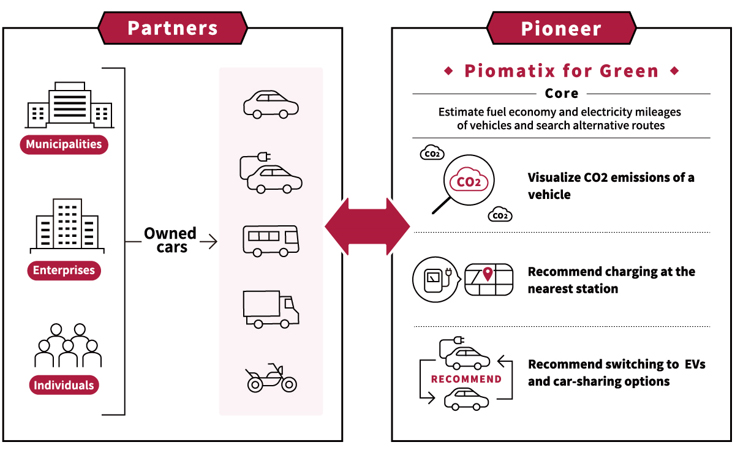News Releaseï¼ڑPioneer Succeeds in Developing Thin Foam/Injection Molding Technology
Information contained in the news release is current as of the date of announcement.
It is subject to change without prior notice.
Tohoku Pioneer Electronic Corporation
Pioneer Electronic Corporation
Pioneer Succeeds in Developing Thin Foam/Injection Molding Technology--- Low Density, Big Malleability and High Internal Loss ---
Tokyo, Japan, April 17, 1997 --- Tohoku Pioneer Electronic Corporation (Share Holder: Pioneer Electronic Corporation 100%, Capital: 4 billion yen. Head Office: Tendo-shi, Yamagata Pref., Japan. President: Souichi Ishijima) and Pioneer Electronic Corporation have announced the development of ultra-thin injection foam technology (thickness 0.25 to1.0 mm, 3 times in foaming magnification) which was not possible with conventional injection molding technology. Using this new technology, mass production of light weight, strong and high internal loss diaphragms for high quality speakers has become possible.
Compared to the conventional diaphragms,the new diaphragms are 1/3 the density, 12 times the rigidity and 1.12 times the internal loss (about 1.5 times compared to the paper diaphragms.)
By changing the proportions of the foaming magnification,the physical properties can be adjusted on a larger scale than the conventional injection molding allows, and this enables a wide variation of design and produces the sound best suited to each speaker system. It is possible to make the elevations and depressions on the diaphragms in order to make its solidity higher. The wall thickness can be also adjusted, resulting in a wide variety of potential speakers. It will be an innovative technology for future speaker production.
Pioneer is planning to introduce car speakers using the new diaphragms in the near future,and is also planning to apply this technology to other resin products as well.
< Background of the Development >
Tohoku Pioneer has long been involved in the injection molding technology for resin diaphragms now widely used for home stereo speakers and car speakers in tough road conditions.
In order to attain high quality sound,performance-enhancing materials such as carbon fibers and mica are added to the resin materials (mainly polypropylene),and this results in less weight, higher solidity and higher internal loss,which is an ideal condition for diaphragms. In this process,Tohoku Pioneer focused its attention on molding technology and molding equipment for such specialized use.
< Method of Producing the Injection Molding --- Patent Pending >
- Resin containing blowing agent is injected into high-temperature molding die rapidly.The blowing agent will be split by heat inside the cylinder,but it will not blow due to high-pressure.
- After the injection is finished, the molding die is opened at a particular place and space is created for foaming. By this procedure,the pressure inside the molding die will decrease and the resin can be blowed.
- As the above mentioned process differs according to several conditions (such as the temperature of the resin,the pressure and the timing of opening the molding die),which depend on the design of the molded product, the thickness,the dimension and its surface condition,a highly accurate computer system is necessary in performing the high-precision injection molding procedure.
- A precisely-made molding die is necessary.
- As the process of the injection foam is very rapid,the time for production of the injection molding is the same as conventional thin molding.
< Main Features of the Injection Foam Diaphragm >
The newly developed injection foam diaphragm has a three-layer construction (the surface-layers are unfoamed skin layers, and the middle-layer is a foamed layer. Due to this construction,it has features as follows:

photo of the layer (conventional diaphragm)

photo of the layer (injection foam diaphragm)
- It is possible to make the foaming magnification up to approx. 3 times, resulting in a light weight diaphragm which is 1/3 the density,thus creating a highly sensitive speaker.
- Compared to the unfoamed diaphragm, a coefficient of elasticity (Young ratio/density ratio) is about 1.4 times,the rigidity(for the same weight, Young ratio multiplied by the third power of the thickness) will be 12 times greater, which results in a high quality speaker with less distortion.
(See attached Diagram 1 and 2.) - As it is able to increase the internal loss by 12%,less distortion and smoother frequency response can be achieved, which results in reproducing natural and clear sound.
(See attached Diagram 3.) - By changing the foaming magnification up to 3 times, the physical properties of the diaphragm can be adjusted so that a wider variety of sounds can be produced.
(See attached Diagram 4.)
Search for Other resources
Search for Keyword
Search by date
-
December 12, 2025Research and developmentPioneer Develops AI Agent for Next-Level in-vehicle infotainment (IVI) with Microsoft Foundry
AI and cloud solutions combine to bring innovative UX and greater safety to a variety of vehicles
-
July 11, 2022Research and developmentHelping to Achieve Carbon Neutrality with Technologies
to Estimate and Predict fuel economy and electricity mileages
of vehicles
-Supporting CO2 emission reductions in the mobility environment
with the proprietary platform â€کPiomatix for Green’-
-
November 25, 2020Research and developmentPioneer’s approach for telematics service for high efficient global logistics in ASEAN Selected for JETRO “The Program for Strengthening Overseas Supply Chainsâ€
- Contributing to improving logistics performance with a logistics planning optimization solution utilizing driving video data -
-
October 13, 2020Research and developmentTohoku Pioneer Agrees to Supply OLED Panels to PolyPhotonix for its Sleep Mask Treating Diabetic Retinopathy

-
February 6, 2020Research and developmentParticipated in an autonomous driving demonstration under 5G environment in Malaysia - Expand demonstration area for commercialization of autonomous driving service in ASEAN region - (PDF 281 KB)

-
January 8, 2020Research and developmentPioneer Unveils “Next-Generation 3D-LiDAR Sensor†Capable of Measurement at Long Distance of 500 m, Exhibits Prototype at CES2020 -Lineup of 1550nm wavelength sensor model, catering to diverse markets and customer needs- (PDF 234 KB)

-
January 8, 2020Research and developmentPioneer Exhibits “3D Data Collection LiDAR kit†Retrofittable on Vehicles at CES 2020 - Detect the environment around the vehicles with high resolution, providing data for map maintenance and other applications - (PDF 273 KB)

-
December 19, 2019Research and developmentPioneer Develops Mass-Production Model of 3D-LiDAR Sensor with Improved Measurement Distance and a Much Compact Size -Models supporting level-three and above autonomous vehicles will be mass-produced in autumn 2020- (PDF 516 KB)

-
May 30, 2019Research and developmentPioneer and Arm Treasure Data Reached an Agreement for Co-Development of Data Analysis/Behavior and Accident Risk Prediction Models Based on AI Technology in Mobility (PDF 105 KB)

-
April 17, 2019Research and developmentPioneer and Canon agree to co-develop 3D-LiDAR sensor, drive the development of compact, high-performance 3D-LiDAR sensors (PDF 88 KB)

